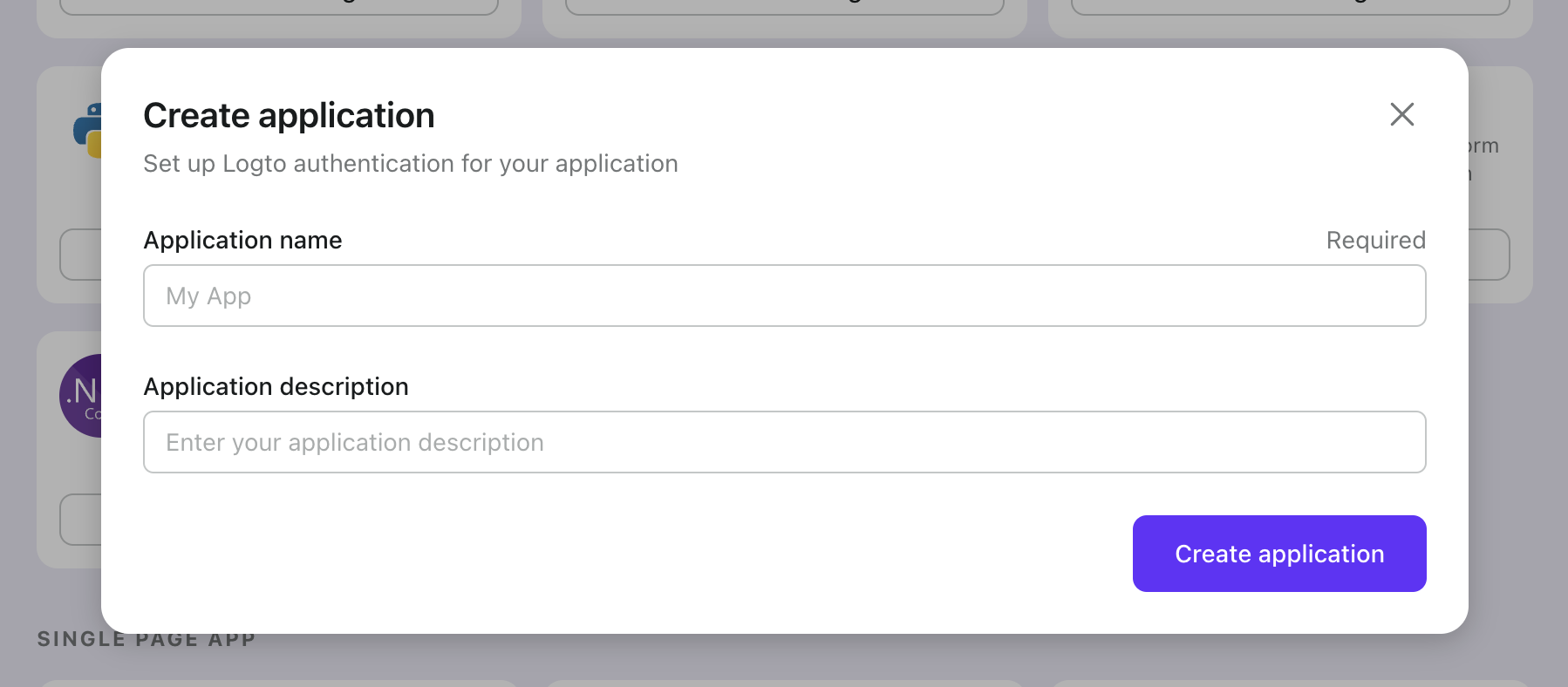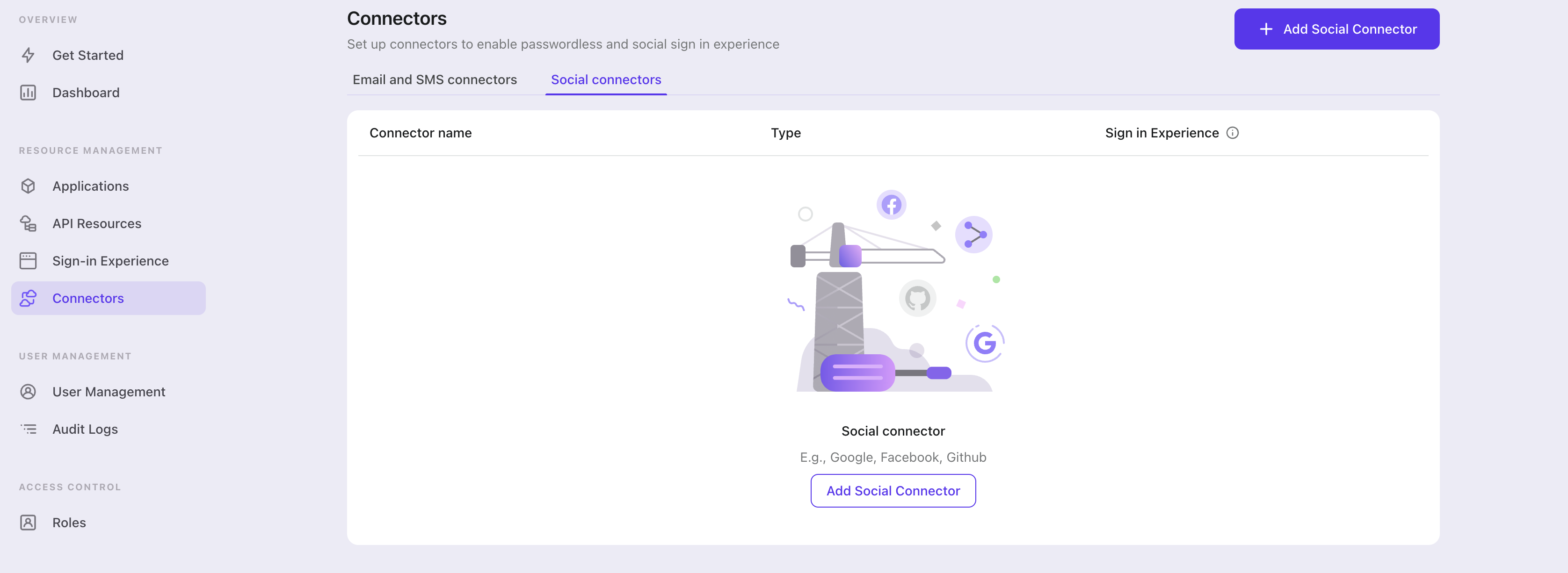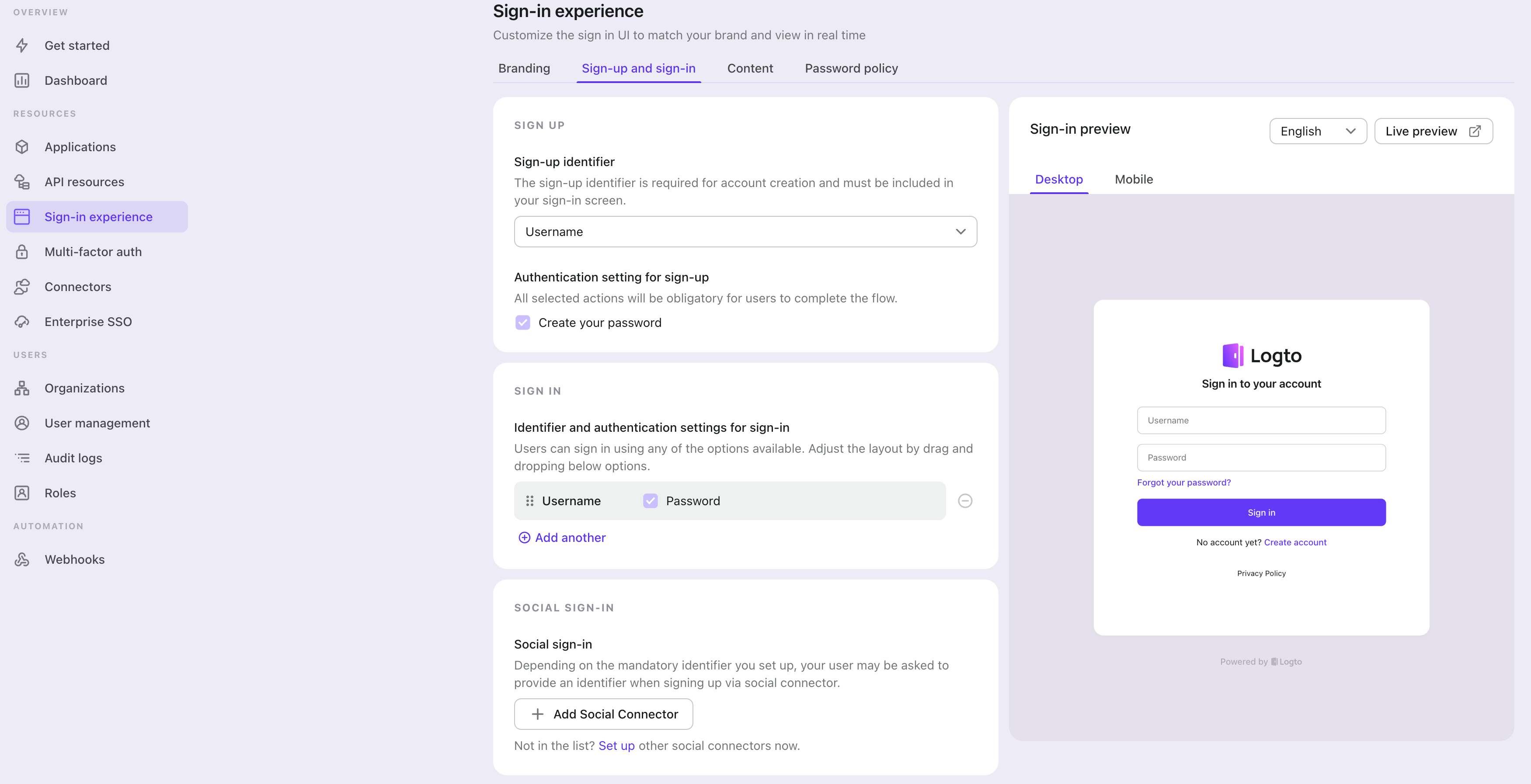Every app needs authentication and authorization. Logto is an Auth0 alternative designed for modern apps and SaaS products.
In this article, we will go through the steps to quickly build the Facebook sign-in experience (user authentication) with Android and Logto.
Prerequisites
- A running Logto instance. Check out the get started page if you don't have one.
- Basic knowledge of Android.
- A usable Facebook account.
Create an application in Logto
In you browser, open a new tab and enter the link of Logto Admin Console.

Once the page is loaded, in the "Get Started" section click the View all link to open the application framework list page.
Choose your application type

In the opening modal, scroll to the "Native app" section or filter all the available " Native app" frameworks using the quick filter checkboxes on the left.
Click the "Android (Kotlin)" / "Android (Java)" framework card to start creating your application.
Enter application name

Enter the application name, e.g., "Bookstore," and click "Create Application."
🎉 Ta-da! You just created your first application in Logto. You'll see a congrats page which includes a detailed integration guide. Follow the guide to see what the experience will be in your application.
Integrate Logto SDK
- The example is based on View system and View Model, but the concepts are the same when using Jetpack Compose.
- The example is written in Kotlin, but the concepts are the same for Java.
- Both Kotlin and Java sample projects are available on our SDK repository.
- The tutorial video is available on our YouTube channel.
Installation
The minimum supported Android API level of Logto Android SDK is level 24.
Before you install Logto Android SDK, ensure mavenCentral() is added to your repository configuration in the Gradle project build file:
dependencyResolutionManagement {
repositories {
mavenCentral()
}
}
Add Logto Android SDK to your dependencies:
- Kotlin
- Groovy
dependencies {
implementation("io.logto.sdk:android:1.1.3")
}
dependencies {
implementation 'io.logto.sdk:android:1.1.3'
}
Since the SDK needs internet access, you need to add the following permission to your AndroidManifest.xml file:
<?xml version="1.0" encoding="utf-8"?>
<manifest xmlns:android="http://schemas.android.com/apk/res/android"
xmlns:tools="http://schemas.android.com/tools">
<!-- add internet permission -->
<uses-permission android:name="android.permission.INTERNET" />
<!-- other configurations... -->
</manifest>
Init LogtoClient
Create a LogtoViewModel.kt and init LogtoClient in this view model:
//...with other imports
import io.logto.sdk.android.LogtoClient
import io.logto.sdk.android.type.LogtoConfig
class LogtoViewModel(application: Application) : AndroidViewModel(application) {
private val logtoConfig = LogtoConfig(
endpoint = "<your-logto-endpoint>", // E.g. http://localhost:3001
appId = "<your-app-id>",
scopes = null,
resources = null,
usingPersistStorage = true,
)
private val logtoClient = LogtoClient(logtoConfig, application)
companion object {
val Factory: ViewModelProvider.Factory = object : ViewModelProvider.Factory {
@Suppress("UNCHECKED_CAST")
override fun <T : ViewModel> create(
modelClass: Class<T>,
extras: CreationExtras
): T {
// Get the Application object from extras
val application = checkNotNull(extras[APPLICATION_KEY])
return LogtoViewModel(application) as T
}
}
}
}
then, create a LogtoViewModel for your MainActivity.kt:
//...with other imports
class MainActivity : AppCompatActivity() {
private val logtoViewModel: LogtoViewModel by viewModels { LogtoViewModel.Factory }
//...other codes
}
Implement sign-in
Before starting, you need to add a redirect URI in the Admin Console for your application.
In Android, the redirect URI follows the pattern: $(LOGTO_REDIRECT_SCHEME)://$(YOUR_APP_PACKAGE)/callback:
- The
LOGTO_REDIRECT_SCHEMEshould be a custom scheme in the reverse domain format. - The
YOUR_APP_PACKAGEis your app package name.
Assuming you treat io.logto.android as the custom LOGTO_REDIRECT_SCHEME, and io.logto.sample is your app package name, the Redirect URI should be io.logto.android://io.logto.sample/callback.
Let's switch to the Application details page of Logto Console. Add a Redirect URI
io.logto.android://io.logto.sample/callback and click "Save Changes".

Redirect URI is an OAuth 2.0 concept which implies the location should redirect after authentication.
After the redirect URI is configured, we add a signIn method to your LogtoViewModel.kt, which will call logtoClient.signIn API to invoke the Logto sign-in page:
//...with other imports
class LogtoViewModel(application: Application) : AndroidViewModel(application) {
// ...other codes
fun signIn(context: Activity) {
logtoClient.signIn(context, "io.logto.android://io.logto.sample/callback") { logtoException ->
logtoException?.let { println(it) }
}
}
}
Now setup on-click listener for the sign-in button in your MainActivity.kt to call the signIn method:
//...with other imports
class MainActivity : AppCompatActivity() {
override fun onCreate(savedInstanceState: Bundle?) {
//...other codes
// Assume you have a button with id `sign_in_button` in your layout
val signInButton = findViewById<Button>(R.id.sign_in_button)
signInButton.setOnClickListener {
logtoViewModel.signIn(this)
}
}
}
When you click the button, the Logto SDK will navigate to the Logto sign-in page.
Implement sign-out
Similar to sign-in, we add a signOut method to LogtoViewModel.kt to call logtoClient.signOut API:
//...with other imports
class LogtoViewModel(application: Application) : AndroidViewModel(application) {
// ...other codes
fun signOut() {
logtoClient.signOut { logtoException ->
logtoException?.let { println(it) }
}
}
}
After you signed out, the Logto SDK will clear all local credentials even though Logto exceptions occurred when calling logtoClient.signOut API.
Then, we can add a button to call the signOut method in MainActivity.kt:
//...with other imports
class MainActivity : AppCompatActivity() {
//...other codes
override fun onCreate(savedInstanceState: Bundle?) {
//...other codes
//...sign-in button codes
// Assume you have a button with id `sign_out_button` in your layout
val signOutButton = findViewById<Button>(R.id.sign_out_button)
signOutButton.setOnClickListener {
logtoViewModel.signOut()
}
}
}
Handle authentication status
In Logto SDK, we can use logtoClient.isAuthenticated to check the authentication status, if the user is signed in, the value will be true, otherwise, the value will be false.
Now, let's add a live data to LogtoViewModel.kt to observe the authentication status, and update the status when the user signed in or signed out:
//...with other imports
class LogtoViewModel(application: Application) : AndroidViewModel(application) {
// ...other codes
// Add a live data to observe the authentication status
private val _authenticated = MutableLiveData(logtoClient.isAuthenticated)
val authenticated: LiveData<Boolean>
get() = _authenticated
fun signIn(context: Activity) {
logtoClient.signIn(context, "io.logto.android://io.logto.sample/callback") { logtoException ->
logtoException?.let { println(it) }
// Update the live data
_authenticated.postValue(logtoClient.isAuthenticated)
}
}
fun signOut() {
logtoClient.signOut { logtoException ->
logtoException?.let { println(it) }
// Update the live data
_authenticated.postValue(logtoClient.isAuthenticated)
}
}
}
Then, we observe the authenticated live data in MainActivity.kt, when the user is signed in, we hide the sign-in button and show the sign-out button and vice versa:
//...with other imports
class MainActivity : AppCompatActivity() {
//...other codes
override fun onCreate(savedInstanceState: Bundle?) {
//...other codes
val signInButton = findViewById<Button>(R.id.sign_in_button)
val signOutButton = findViewById<Button>(R.id.sign_out_button)
// ...handle button click codes
// Observe the authentication status
logtoViewModel.authenticated.observe(this) { authenticated ->
if (authenticated) {
// The user is authenticated
signInButton.visibility = View.GONE
signOutButton.visibility = View.VISIBLE
} else {
// The user is not authenticated
signInButton.visibility = View.VISIBLE
signOutButton.visibility = View.GONE
}
}
}
}
Open your Android app to test if the integration works. When you click the "Sign In" button, the page should be redirected to a Logto sign-in page, and you should be able to create a new account by entering username and password and complete the sign-in process.
Add Facebook connector
To add a social connector, go to the "Connector" tab in the Admin Console, then click on "Social Connectors". From there, click "Add Social Connector".

In the openning modal, select "Facebook" and click "Next".
On the next page, you will see a two-column layout with the README content on the left and configuration on the right.
Feel free to follow the README file in place or read the following section to complete the configuration process. If you follow the in-place guide, you can skip the next section.
Set up Facebook login
Register a Facebook developer account
Register as a Facebook Developer if you don't have one.
Set up a Facebook app
- Visit the Apps page.
- Click your existing app or create a new one if needed.
- The selected app type is up to you, but it should have the product Facebook Login.
- On the app dashboard page, scroll to the "Add a product" section and click the "Set up" button on the "Facebook Login" card.
- Skip the Facebook Login Quickstart page, and click the sidebar -> "Products" -> "Facebook Login" -> "Settings".
- In the Facebook Login Settings page, fill
${your_logto_origin}/callback/${connector_id}in the "Valid OAuth Redirect URIs" field. Theconnector_idcan be found on the top bar of the Logto Admin Console connector details page. E.g.:https://your-logto-domain.com/callback/${connector_id}for productionhttps://localhost:3001/callback/${connector_id}for testing in the local environment
- Click the "Save changes" button at the bottom right corner.
- In the Facebook app dashboard page, click the sidebar -> "Settings" -> "Basic" and then you will get the App ID and App secret. The App ID is the
clientIdin your Logto connector conifg and the App secret is theclientSecret.
Test sign-in with Facebook's test users
You can use the accounts of the test, developer, and admin users to test sign-in with the related app under both development and live app modes.
You can also set the app to "live mode" by switching modes so that any Facebook user can sign in with the app.
- In the app dashboard page, click the sidebar -> "Roles" -> "Test Users".
- Click the "Create test users" button to create a testing user.
- Click the "Options" button of the existing test user, and you will see more operations, e.g., "Change name and password".
Publish Facebook sign-in settings
Usually, only the test, admin, and developer users can sign in with the related app under development mode.
To enable normal Facebook users sign-in with the app in the production environment, you may need to switch your Facebook app to live mode, depending on the app type. E.g., the pure business type app doesn't have the "live" switch button, but it won't block you from using it.
- In the Facebook app dashboard page, click the sidebar -> "Settings" -> "Basic".
- Fill out the "Privacy Policy URL" and "User data deletion" fields on the panel if required.
- Click the "Save changes" button at the bottom right corner.
- Click the "Live" switch button on the app top bar.
References
Config types
| Name | Type |
|---|---|
| clientId | string |
| clientSecret | string |
Facebook developer docs
- Facebook Login - Documentation - Facebook for Developers
- Manually Build a Login Flow
- Permissions Guide
Save your configuration
Double check you have filled out necessary values in the Logto connector configuration area. Click "Save and Done" (or "Save Changes") and the Facebook connector should be available now.
Enable Facebook connector in Sign-in Experience
Switch to the "Sign-in Experience" tab, then click the "Sign-up and Sign-in" tab.
If it's the first time you enter the tab, you will see a quick introduction about Sign-in Experience and its basic configuration.

Select "None" for the "Sign-up identifier" to provide minimum sign-up effort for Facebook sign-in, which may increase your conversion rate.
In the "Social sign-in" section, add "Add Social Connector" and choose "Facebook". Then you should be able to see a button with text "Continue with Facebook" in the preview section.

Finally, click "Save Changes" on the bottom right corner.
Testing and Validation
Return to your Android app. You should now be able to sign in with Facebook. Enjoy!
Further readings
⚔️ Protect your API For native and single page apps, you'll need to call one or more API endpoints to retrieve and update data.
Learn more about identifying who's who and keeping your API secure.
🧑🚀 Manage users We know you care about user management and activities, as we also do.
Learn more about how to know your users and see the figures like DAU and MAU graphically.
🌐 Localization From one regional business to a global corporate, the willingness to offer the best user experience won't change.
You can change current language phrases or add a new language without friction.
🧑🎓 Customer IAM series Our serial blog posts about Customer (or Consumer) Identity and Access Management, from 101 to advanced topics and beyond.
